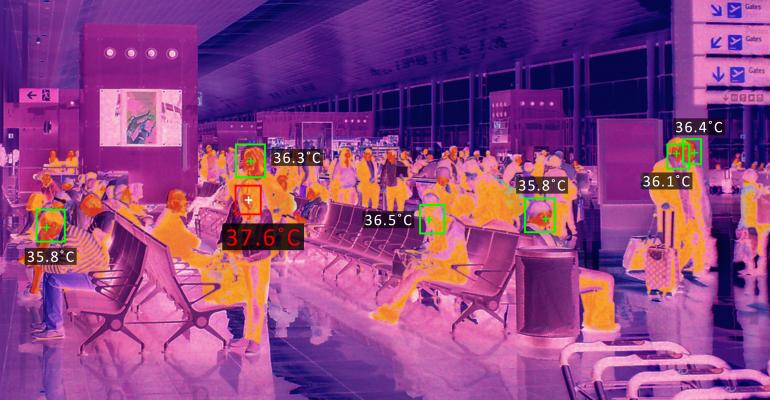As lockdown rules begin to loosen around the U.S. and the rest of the world, air travel is beginning to pick up again. According to a report by NPR.com, the Transportation Security Administration confirmed that airport screenings across the country were over 300,000 on May 21 for the first time in two months. That’s still a tiny amount compared to last year before the Memorial Day long weekend, when more than 2.67 million travelers boarded planes, but it is 200,000 more than the average single-day screenings since the pandemic hit.
What will flyers find when they arrive at the airport for screenings? Well, it depends on the airport and the country.
In the Unites States, there is still debate over who has responsibility for passenger health screenings—the TSA, Homeland Security, the airport, or the airline.
There are currently no federal requirements for passengers to wear masks or for airlines to reduce capacity, although the latest TSA guidelines say, “Travelers are encouraged to wear face protection to the [security] checkpoint.” Other U.S. guidelines ask flyers to scan paper boarding passes or etickets themselves, and then hold them up for security personnel to read. Any food in carry-on bags should be placed in clear plastic bags in bins so that TSA personnel don’t have to open bags to check it, but keys, coins, and other small metal items should be placed in bags so that they can be X-rayed versus risking contamination in bins. All U.S. airports are providing enhanced cleaning, and many are experimenting with ultraviolet sanitizing techniques for high-touch surfaces such as X-ray trays and even adopting UV cleaning robots.
Internationally, ultraviolet light is being used at India’s Delhi Airport in handheld devices and baggage conveyer belt tunnels. In addition, the airport has passengers walk on disinfecting mats to remove the virus from shoes, sprays luggage with disinfectant, and does temperature checks. (Watch this video from Bloomberg.)
Britain’s busiest airport, Heathrow, is providing masks to passengers who arrive without a face covering, and earlier this month began experimenting with thermal screening technology.
to see if passenger temperature checks are effective in alerting authorities to possible COVID-19 infected flyers. This idea has been discounted by the Centers for Disease Control and Prevention.
Another British trial involves deploying dogs trained to sniff out the virus at points of entry into the U.K., including airports. The trial is designed and monitored by London’s School of Hygiene and Tropical Medicine, which has had previous success with bio-detection dogs detecting patients with malaria and other blood-borne illnesses.
The most draconian measures appear to be in place in Hong Kong International Airport and are outlined in this video by Laurel Chor, posted on The Points Guy.
Chor, a journalist returning home to Hong Kong from Paris, is tested for the virus and spends six hours at the Asia World Expo convention center waiting for her tests results and being fitted for a tracking bracelet. She tests negative but is still required to spend two weeks in quarantine.
Vienna Airport is also offering COVID-19 tests to arriving passengers for a fee of just over $200. Passengers have to make a reservation at the testing center adjacent to the airport, and are required to wait up to three hours for the results. If they are negative, they don’t need to quarantine. If positive, the authorities are informed and the passenger will be required to quarantine. In this video, Gunther Ofner, Vienna Airport chief financial officer, stresses that the current testing availability is only possible because of reduced passenger numbers. However, since quarantine is likely to deter most business travelers, it’s possible that airports around the world will have to scale-up test-processing facilities before companies will allow employees to languish in a hotel for two weeks before meetings.





